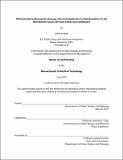| dc.contributor.advisor | Lawrence J. Vale. | en_US |
| dc.contributor.author | Stein, Julie Iris | en_US |
| dc.contributor.other | Massachusetts Institute of Technology. Dept. of Urban Studies and Planning. | en_US |
| dc.coverage.spatial | n-us-ny | en_US |
| dc.date.accessioned | 2010-10-29T13:56:58Z | |
| dc.date.available | 2010-10-29T13:56:58Z | |
| dc.date.issued | 2010 | en_US |
| dc.identifier.uri | http://hdl.handle.net/1721.1/59583 | |
| dc.description | Thesis (M.C.P.)--Massachusetts Institute of Technology, Dept. of Urban Studies and Planning, 2010. | en_US |
| dc.description | This electronic version was submitted by the student author. The certified thesis is available in the Institute Archives and Special Collections. | en_US |
| dc.description | "June 2010." Cataloged from student submitted PDF version of thesis. | en_US |
| dc.description | Includes bibliographical references. | en_US |
| dc.description.abstract | Westchester County, NY was sued by the Anti-Discrimination Center of Metro New York, Inc. (ADC) under the False Claims Act for allegedly failing to meet its Affirmatively Further Fair Housing obligation for Community Development Block Grant funds received between 2000 and 2006. While Westchester County argued that it had an impressive affordable housing development record, ADC claimed that the County had not done the required Analysis of Impediments to fair housing choice vis-à-vis race and that the County had not taken steps to overcome known impediments to fair housing stemming from racial discrimination and segregation. The lawsuit ended in an August 2009 settlement that requires Westchester County to spend $51.6 million to build 750 units of affordable housing by 2016 in the 31 municipalities in Westchester with the lowest percentage of minority residents. This case could set a precedent for areas nationwide that have historically resisted residential desegregation. This thesis examines the challenges faced by stakeholders when implementing a court-ordered fair housing plan. It asks the question: In the face of various barriers to implementation, how does Westchester County get the required affordable Affirmatively Furthering Fair Housing units built in compliance with both the letter and the spirit of the settlement? To frame the setting of the lawsuit and settlement, this thesis describes the history of the development of Westchester County and examines the federal housing policy context that shaped its suburban landscape. I then provide a detailed case study of the Westchester County False Claims lawsuit, settlement agreement, and implementation plan. Finally, I analyze barriers that the Westchester County Executive's Office will face in trying to implement the settlement agreement, and I provide political, policy and design recommendations for overcoming these barriers. | en_US |
| dc.description.statementofresponsibility | by Julie Iris Stein. | en_US |
| dc.format.extent | 211 p. | en_US |
| dc.language.iso | eng | en_US |
| dc.publisher | Massachusetts Institute of Technology | en_US |
| dc.rights | M.I.T. theses are protected by
copyright. They may be viewed from this source for any purpose, but
reproduction or distribution in any format is prohibited without written
permission. See provided URL for inquiries about permission. | en_US |
| dc.rights.uri | http://dspace.mit.edu/handle/1721.1/7582 | en_US |
| dc.subject | Urban Studies and Planning. | en_US |
| dc.title | Affirmatively furthering fair housing : overcoming barriers to implementation of the Westchester County, NY false claims case settlement | en_US |
| dc.title.alternative | Overcoming barriers to implementation of the Westchester County, NY false claims case settlement | en_US |
| dc.type | Thesis | en_US |
| dc.description.degree | M.C.P. | en_US |
| dc.contributor.department | Massachusetts Institute of Technology. Department of Urban Studies and Planning | |
| dc.identifier.oclc | 671236233 | en_US |
